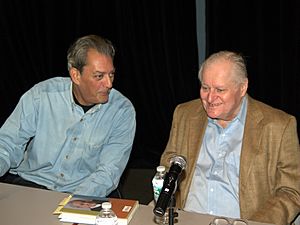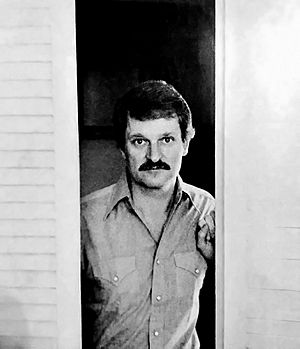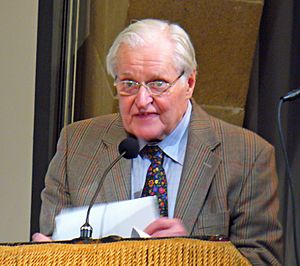John Ashbery facts for kids
Quick facts for kids
John Ashbery
|
|
|---|---|

Ashbery in 2010
|
|
| Born | John Lawrence Ashbery July 28, 1927 Rochester, New York, U.S. |
| Died | September 3, 2017 (aged 90) Hudson, New York, U.S. |
| Occupation | Poet, professor, and art critic |
| Alma mater | Harvard University Columbia University |
| Period | 1949–2017 |
| Literary movement | Surrealism, The New York School, Postmodernism |
| Notable works | Self-Portrait in a Convex Mirror |
| Notable awards | MacArthur Fellowship, Pulitzer Prize for Poetry, National Book Award, National Book Critics Circle Award, Guggenheim Fellowship |
| Spouse | David Kermani |
| Signature | |
John Ashbery was an American poet and art critic. He lived from 1927 to 2017. Many people consider him one of the most important American poets of his time.
A literary critic from Oxford University, John Bayley, said Ashbery's poetry captured the "standard tones of the age." Langdon Hammer, who leads the English Department at Yale University, said in 2008 that "No figure looms so large in American poetry over the past 50 years as John Ashbery." He also noted that Ashbery had a huge vocabulary, even bigger than famous poets like Walt Whitman or Ezra Pound.
Ashbery published over 20 books of poetry. He won almost every major American award for poetry. This included a Pulitzer Prize in 1976 for his book Self-Portrait in a Convex Mirror. Ashbery once said he wanted his poems to be understood by many people, not just himself.
Contents
Early Life and Education
John Lawrence Ashbery was born in Rochester, New York. His mother, Helen, was a biology teacher. His father, Chester, was a farmer. John grew up on a farm near Lake Ontario. Sadly, his brother died when they were children.
Ashbery went to Deerfield Academy, an all-boys school. There, he started reading poets like W. H. Auden and Dylan Thomas. He also began writing his own poetry. Some of his early poems were even published in Poetry magazine. He also wrote for his school newspaper.
Before becoming a poet, Ashbery wanted to be a painter. From age 11 to 15, he took art classes every week in Rochester.
College Years and Early Career
In 1949, Ashbery graduated with honors from Harvard College. At Harvard, he was part of the Harvard Advocate, a literary magazine. He also made friends with other writers like Kenneth Koch and Frank O'Hara. After Harvard, he studied briefly at New York University. He then earned a master's degree from Columbia University in 1951.
From 1951 to 1955, Ashbery worked as a copywriter in New York. Then, in the mid-1950s, he received a special scholarship called a Fulbright Fellowship. This allowed him to live in France until 1965.
While in France, he worked as an editor for a magazine called Art and Literature. He also translated French mystery novels to earn money. He was an art editor for a European newspaper and an art critic for several magazines. During this time, he translated works by famous French writers like Arthur Rimbaud.
Return to the United States
Ashbery moved back to New York near the end of 1965. He continued his work as an art critic for magazines like New York and Newsweek. He also served on the editorial board of ARTnews. Later, he became an editor at Partisan Review from 1976 to 1980.
In 1963, Ashbery met the famous artist Andy Warhol. Ashbery had written good reviews about Warhol's art. He even reviewed Warhol's Flowers art show in Paris. Ashbery became good friends with Gerard Malanga, who was Warhol's assistant.
In the early 1970s, Ashbery started teaching at Brooklyn College. One of his students there was the poet John Yau. In 1983, he was chosen as a Fellow of the American Academy of Arts and Sciences.
Later, in the 1980s, he moved to Bard College. He taught there until 2008. Even after retiring, he kept winning awards and giving readings. From 2001 to 2003, he was the poet laureate of New York State. He also served for many years as a leader of the Academy of American Poets.
In 2008, Ashbery became the first poet laureate for MtvU. This is a part of MTV that broadcasts to college campuses. His poems were featured in many short videos.
Ashbery passed away peacefully on September 3, 2017, at his home in Hudson, New York. He was 90 years old.
Poetry and Style
Ashbery's long list of awards began in 1956. He won the Yale Younger Poets Prize for his first collection, Some Trees. The famous poet W. H. Auden chose his book for the award.
Ashbery's early poems were influenced by poets like Auden and Wallace Stevens. He also translated many works from French surrealists. Surrealism is an art movement that uses dream-like images.
In the late 1950s, an art gallery owner named John Bernard Myers grouped Ashbery's poetry with other poets. He called their style the "New York School." This group included poets like Kenneth Koch and Frank O'Hara. Even though their styles were different, they were all part of this new movement.
Ashbery wrote two more collections while living in France: The Tennis Court Oath (1962) and Rivers and Mountains (1966). After returning to New York, he wrote The Double Dream of Spring, published in 1970.

In the 1970s, more and more critics started to notice Ashbery's work. He went from being an experimental poet to one of America's most important. After his book Three Poems (1973), he published Self-Portrait in a Convex Mirror. This book won him three major American poetry awards: the Pulitzer Prize, the National Book Award, and the National Book Critics Circle Award. The main poem in this collection is seen as a masterpiece of American poetry from the late 20th century.
His next books, Houseboat Days (1977) and As We Know (1979), further cemented his reputation. By the 1980s and 1990s, Ashbery was a central figure in English-language poetry. Many other poets tried to write like him.
Ashbery's poems often have a flowing, sometimes disconnected style. He loved to play with language and often used humor. His poems often explore how the human mind works. He once said his goal was to write a poem that critics couldn't even talk about.
While his early poems were more traditional, his later work became more experimental. He used different sentence structures and changed tones quickly. He also kept his clever wit throughout his work.
Other Writings
Ashbery's writings about art were collected in a book called Reported Sightings, Art Chronicles 1957–1987. He also wrote one novel, A Nest of Ninnies, with fellow poet James Schuyler. When he was younger, he wrote several plays. Three of these plays were collected in a book called Three Plays (1978).
His lectures at Harvard University were published as Other Traditions in 2000. A larger collection of his prose (non-poetry) writings, Selected Prose, came out in 2005. In 2008, his Collected Poems 1956–1987 was published. This made Ashbery the first living poet to have his work included in the prestigious Library of America series.
Awards and Honors
- 1956: Yale Younger Poets Prize, for Some Trees (1956) chosen by W.H. Auden
- 1962: Ingram Merrill Foundation Fellowship
- 1972: Ingram Merrill Foundation Fellowship
- 1976: National Book Award for Self-Portrait in a Convex Mirror (1975).
- 1976: National Book Critics Circle Award for Self-Portrait in a Convex Mirror (1975).
- 1976: Pulitzer Prize in Poetry for Self-Portrait in a Convex Mirror (1975).
- 1984: Lenore Marshall Poetry Prize for A Wave (1984)
- 1984: Bollingen Prize in Poetry for A Wave (1984)
- 1985: MacArthur Fellows Program Fellowship
- 1987: Golden Plate Award of the American Academy of Achievement
- 1995: Robert Frost Medal
- 2002: Awarded the rank of Officier de la Légion d'honneur by the Republic of France.
- 2005: Finalist for National Book Award for Where Shall I Wander (2005)
- 2008: Robert Creeley Award
- 2008: America Award for a lifetime contribution to international writing
- 2011 National Humanities Medal
- 2011: Inducted into the New York Writers Hall of Fame
- 2011: National Book Foundation Medal for Distinguished Contribution to American Letters
- 2017: The Raymond Roussel Society Medal
Images for kids
See also
 In Spanish: John Ashbery para niños
In Spanish: John Ashbery para niños




